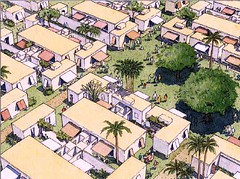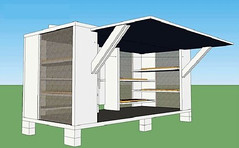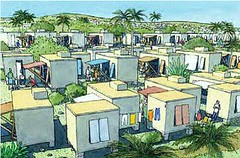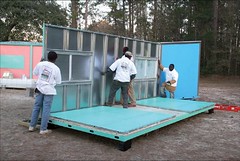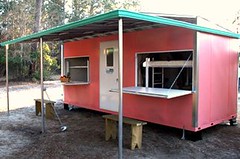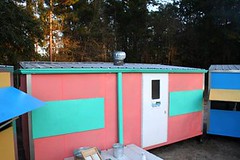Haiti update: Mourning, builder, architects donate emergency homes, work for more

Posted March 2, 2010 at 1:27PM
Former Georgetown University and Miami Heat basketball star Alonzo Mourning has always acted with intensity and purpose, as anyone on the receiving end of one of the nearly 3000 shots he blocked during his playing career can attest. Now those attributes are being channeled into helping others, especially the people of Haiti, where over 200,000 people lost their lives and at least twice that number lost their homes in the January earthquake.
In the face of such an enormous scale of tragedy, any one person’s – or one group’s – contribution seems miniscule. But it is nonetheless significant when someone of stature steps up. In ‘Zo’s case, that meant more or less immediate fundraising through his foundation and its progeny, the Athletes Relief Fund for Haiti, co-founded with former teammate and current Heat star Dwayne Wade. Their effort has already raised some $800,000 from NBA and NFL players and alums.
Some of those funds are being applied to an effort with Miami-based prefab construction builder InnoVida and architect Andres Duany to get emergency homes on the ground, quickly. As I wrote two weeks ago, Duany has designed homes that can be manufactured offsite, easily shipped in flat-pack form, and then assembled locally in a day or less. They are made of durable materials that can withstand severe weather events and may be configured in a variety of ways to suit families’ and communities’ needs (see illustrations). The group is donating 1000 of the homes immediately, and InnoVida is also moving to establish a manufacturing facility in Haiti that can build 10,000 more while providing job opportunity and training to Haitians.
The video I embedded in my previous post – made only two weeks into their work -- reveals the thoughtful approach that the Duany and InnoVida have taken, and all of us must wish them every possible success. You can learn all about the Haitian cabins, their technology, types, assembly and application in this well-illustrated publication. Sample from the opening pages, delineating some of their key characteristics:
- Are built fast. Structures that are 160 sq ft (like the Starter Cabin) can be built in 12 hours. This is nearly 70% faster than traditional construction.
- Are high-quality, durable, non-flammable, waterproof and do not provide a food source for algae or mold growth.
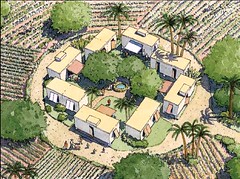
- Are strong enough to withstand earthquakes, floods, tornados, hurricanes, fires and other natural disasters.
- Promote a healthier global environment by producing very little construction-site waste, air pollution and natural-resource consumption.
- Can be built with no heavy equipment and unskilled labor.
- Significantly reduces the amount of energy needed to heat and/or cool the structure and provides excellent noise reduction.
- Can furnish built-in platform beds, table, desk, closets, cabinets, and water and septic tanks.
- Can be covered with any desired finish (paint, stone, stucco, wallpaper, etc.), but it is not required to do so.
The basic cabin (there is a range of types) can sleep up to eight people.
As promising as this effort is, no one person or company has “the” idea that can put Haiti back on some kind of path towards humanity, to say nothing of sustainability. We will also need many other efforts to succeed. The “Haiti House” built by Harbor Homes, for example, uses a similar flat-pack, prefab and assembly concept, but with aluminum and steel rather than composite fiber:
Cameron Sinclair of Architecture for Humanity emphasizes on The Huffington Post that no one should be naïve about the amount of time rebuilding will take:
“When we are rebuilding, do not let the media set the time line and expectations for reconstruction. I remember vividly well known news personalities standing on the rubble of homes in the lower ninth proclaiming that 'this time next year we will see families back home.' Some well meaning NGOs, who usually have little building experience, are even worse -- 'we'll have 25,000 Haitians back home if you donate today.' In reality, here is what it really looks like;
- Pre-Planning Assessments and Damage Analysis (underway, will run for a year)
- Establish Community Resource Center and Reconstruction Studio (Week 6 to Month 3)
- Sorting Out Land Tenure and Building Ownership (Month 6 to Year 5)
- Transitional Shelters, Health Clinics and Community Structures (Month 6 to Year 2)
- Schools, Hospitals and Civic Structures (Month 9 to Year 3)
- Permanent Housing (Year 1 to Year 5)”
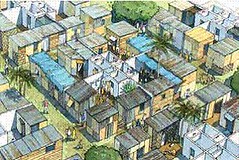 Stefanos Polyzoides, like Duany a co-founder of the Congress for the New Urbanism, also has some thoughtful suggestions that stress the importance of using local labor.
Stefanos Polyzoides, like Duany a co-founder of the Congress for the New Urbanism, also has some thoughtful suggestions that stress the importance of using local labor.
What has been sad to read, unfortunately, has been a surprising amount of sniping in the comments sections of web postings (for example, here and here), with various proponents of particular approaches stressing why one or the other of these efforts is misplaced. In my humble opinion Haiti needs all ideas and as much effort from talented people as possible. Sinclair said it best:
“There is no 'ownership' in rebuilding lives. It sickens me when I hear agencies say their processes are proprietary. If you like what we are doing either support us or steal this plan. We need dozens of tug boat NGOs working together to build back Haiti better. Let's not waste donor dollars on working in silos. Haiti has suffered enough.”
This 97-second news clip from a Miami TV station (that has not enabled embedding, unfortunately, so the link takes you offsite) gives a great mini-tour of the Mourning/InnoVida/Duany effort. Check it out. 'Zo looks like he could still play, and heaven knows my Georgetown Hoyas could use him right now if that were possible.

